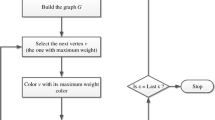Abstract
Cognitive radio has been regarded as a promising technology to improve spectrum utilization significantly. Many studies have discussed underlay spectrum sharing and power control, but issues such as the interference of the primary system have just been considered as the constraint. In this paper, we build a spectrum allocation mathematical model which considers different interference intensity according to relative geographic locations between two SLs in the spectrum-sharing mode of cognitive radio network. Then it’s converted into multi-objective optimization problem. To solve the spectrum sharing problem, the multi-objective improved genetic algorithm is adopted. Simulation results show that our proposed methods greatly outperform the commonly used K-max-cut in graph theory. It can better realize the network benefit maximization and reduce the disturbance to the primary system by using the multi-objective optimization algorithm.






Similar content being viewed by others
References
Wen, K., Fu, X., & Chen, X. (2012). Distributed channel allocation algorithm based on classifying of services and channel in cognitive radio networks. Computer Engineering and Design, 33(9), 3381–3385.
Liang, Y. C., Chen, K. C., Li, G. Y., et al. (2011). Cognitive radio networking and communications: an overview. IEEE Transactions on Vehicular Technology, 60(7), 3386–3407.
Mansoor, N., Islam, A. K. M. M., Zareei, M., Baharun, S., Wakabayashi, T., & Komaki, S. (2015). Cognitive radio ad-hoc network architectures: A survey. Wireless Personal Communications, 81(3), 1117–1142.
Chang, N. B., & Liu, M. (2009). Optimal channel probing and transmission scheduling for opportunistic access. IEEE/ACM Transactions on Networking, 17(6), 1805–1818.
Feng, W., & Jiang, W. (2015). Primary network interference compensation-based dynamic spectrum leasing and secondary network power control. Wireless Personal Communication, 82, 965–992.
Huang, L., Liu, C., & Wang, S. (2010). Improved spectrum sharing model in cognitive radios based on game theory. Journal on Communications, 31(2), 136–140.
Dou, Y., Wang, M., Bai, B., Chen, W., & Cao, Z. (2015). A mechanism for low-complexity joint resources sharing based on game theory in cognitive radio networks. Journal of Electronics & Information Technology, 37(1), 158–162.
Gandhi, S., Buragohain, C., Cao, L., et al. (2009). Towards real time dynamic spectrum auctions. Computer Networks, 52(4), 879–897.
Zhang, S., Zhang, G., & Bao, Z. (2013). Agent-based dynamic spectrum trading algorithm in cognitive network. Journal on Communications, 34(3), 119–125.
Niyato, D., & Hossain, E. (2009). Dynamics of multiple-seller and multiple-buyer spectrum trading in cognitive radio networks: A game theoretic modeling approach. IEEE Transactions on Mobile Computing, 8(8), 1009–1022.
Peng, C. Y., Zheng, H. T., & Zhao, B. Y. (2006). Utilization and fairness in spectrum assignment for opportunistic spectrum access. Mobile Networks and Applications, 11(4), 555–576.
Liao, C., Chen, J., & Tang, Y. (2007). Parallel algorithm of spectrum allocation in cognitive radio. Journal of Electronics & Information Technology, 29(7), 1608–1611.
El-Nainay, M. Y. (2009). Island genetic algorithm-based cognitive networks. Blacksburg: Virginia Polytechnic Institute and State University.
Chai, Z., & Liu, F. (2010). Spectrum allocation of cognitive wireless network based on immune clone selection optimization. Journal on Communications, 31(11), 92–100.
Qiu, T., Xu, W., He, Z., et al. (2011). Graph-based spectrum sharing for multiuser OFDM cognitive radio networks. Wireless Communications and Signal Processing, 1–5.
Acknowledgements
The research work is supported by Nation Nature Science Foundation of China (No. 51507063), Beijing Nature Science Foundation (No. 4142049), and Nation 863 Program (No. 2014AA01A701).
Author information
Authors and Affiliations
Corresponding author
Rights and permissions
About this article
Cite this article
Wu, Rz., Gao, Ly., Tang, Lr. et al. Optimal Spectrum Allocation of Cognitive Radio Network Under Underlay Model. Wireless Pers Commun 97, 469–481 (2017). https://doi.org/10.1007/s11277-017-4514-7
Published:
Issue Date:
DOI: https://doi.org/10.1007/s11277-017-4514-7




